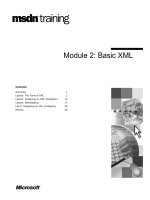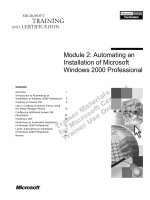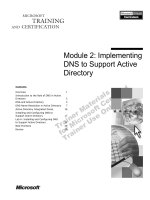Tài liệu Module 2: Solution Design Processes pdf
Bạn đang xem bản rút gọn của tài liệu. Xem và tải ngay bản đầy đủ của tài liệu tại đây (413.09 KB, 22 trang )
Module 2: Solution Design Processes
Module 1: Course
Overview
Module 4: Deriving a
Logical Data Design
Module 5: Normalizing the
Logical Data Design
Module 6: Deriving a
Physical Data Design
Module 7:
Implementing Data
Integrity
Module 2: Solution
Design Processes
Module 3: Using a
Conceptual Design for Data
Requirements
Module 8: Designing
Data Services
Module 9: Data Storage
Considerations
Designing Data
Services and
Data Models
Design
Processes
Services-Based
Design
Activity 2.1: Identifying
Services
Module 2: Solution Design
Processes
Module 2: Solution Design Processes 25
!
!!
! Overview
"
Design Processes
"
Services-Based Design
"
Review
In this module...
In this module...
At the end of this module, you will be able to:
"
Explain design processes as they pertain to business solutions and data-
centric solutions.
"
Explain the concepts and benefits of services-based design.
"
Identify phases in the project life cycle.
This module provides a high-level overview of the MSF Process Model,
the MSF Design Process Model, and the MSF Application Model. The courses
in the MSF curriculum cover these topics in greater detail. For more
information about the MSF curriculum, see
Slide Objective
To provide an overview of
the module topics and
objectives.
Lead-in
In this module, you will learn
about the MSF Process
Model, the MSF Design
Process Model, and the
MSF Application Model, as
well as Windows DNA.
Note
26 Module 2: Solution Design Processes
!
!!
! Design Processes
"
The MSF Process Model
"
Requirements Gathering
"
The MSF Design Process Model
"
Data and the MSF Design Process Model
"
Benefits of the Design Process
In this section...
In this section...
In this section, you will learn about design processes and the MSF Process
Model. You will see how these processes form an application model for
solution design and how the design processes interact with each other.
Slide Objective
To explain the purpose of
this section and what
students will learn in this
section.
Lead-in
In this section, you will learn
about design processes for
business and data-centric
solutions.
Module 2: Solution Design Processes 27
The MSF Process Model
"
Course 1608 also covers the Planning Phase, but it
focuses on application design
Release
Release
Course 1609
Scope
Complete
Scope
Complete
Vision
Approved
Vision
Approved
Project Plan
Approved
Project Plan
Approved
Microsoft
®
advocates the MSF Process Model for Application Development as
the recommended project life cycle model for business-solution software
development projects.
The MSF Process Model is phase-based, meaning that each project is broken
into distinct phases so that the team and key stakeholders understand where the
project is in the life cycle and what key tasks are being accomplished.
The MSF Process Model is milestone driven, meaning that each phase
culminates with a deliverable-based milestone that marks the team’s progress.
This milestone creates a point of transition, synchronizes the project team and
customer, and allows for review and possible corrective action.
The phases of the MSF Process Model are as follows:
"
The Envisioning Phase is the period during which the team and customer
define the business requirements and overall goals of the project. The
Envisioning Phase culminates in the Vision Approved Milestone, indicating
that the team and customer agree on project direction.
"
The Planning Phase is the period during which the team and customer
define what will be built, as well as how and when it will be built. The
Planning Phase culminates in the Project Plan Approved Milestone,
indicating that the team, customer, and key stakeholders agree on what will
be delivered and when.
"
The Developing Phase is the period during which the team implements the
design and builds the application. The Developing Phase culminates in the
Scope Complete Milestone, indicating that code for all features is complete
and that the product is ready for external testing and stabilization.
Slide Objective
To describe the four phases
and the four major
milestones of the MSF
Process Model and to
explain which phase of the
MSF Process Model will be
covered in this course.
Lead-in
This course focuses on the
beginning stages of the
Envisioning Phase of the
MSF Process Model.
Delivery Tip
Point out that these are
standard, major milestones,
but that each project will
also have its own unique
interim milestones.
The model is conceptual, so
it does not represent ratios
of duration.
Each phase and major
milestone will be examined
in more detail in later
modules.
28 Module 2: Solution Design Processes
"
The Stabilizing Phase is the period during which team efforts are directed at
addressing all known issues (from code defects to mismanaged
expectations). No new development occurs during this phase; rather, the
application code is stabilized and optimized. The Stabilizing Phase
culminates in the Release Milestone, at which point responsibility for the
product shifts to the operations team.
This course focuses on the Planning Phase of the MSF Process Model. You will
learn how to take the requirements gathered in the Envisioning Phase and turn
them into a data design and data services.
This course leads into the Project Plan Approved Milestone, which signals that
the functional specification of the application is complete to a point that it can
begin to be implemented.
Module 2: Solution Design Processes 29
Requirements Gathering
"
When you gather information, you identify:
$
Business needs
$
Business processes
$
Existing systems
$
System actors
"
This process results in:
$
Business justification for the project
$
Description of the current system
$
Description of the application needed
Before any business and data solution can be built, both the problem and the
desired solution must be understood. This understanding is not always easy to
achieve, and complete, reliable information is critical for good decision-
making. When gathering information, you need to consider business needs,
business processes, existing systems, and the people involved.
The process of gathering information and requirements leads to a business
justification for the project. It also generates descriptions of what actions and
processes (if any) the current system performs and what the future application
needs to do to satisfy the requirements.
Slide Objective
To introduce topics related
to the gathering of data.
Lead-in
Data gathering forms the
basis for all future design
processes.
30 Module 2: Solution Design Processes
The MSF Design Process Model
Conceptual Design
Scenarios
Services and Objects,
User Interface, and
Logical Database
Logical Design
Components,
User Interface, and
Physical Database
Physical Design
The MSF Design Process Model consists of three design phases—conceptual,
logical, and physical—which are described as follows:
"
Conceptual design
The goal in conceptual design is to identify business needs and to
understand what users do and what they require. The design team views the
problem from the perspectives of the user and the business and defines the
problem and solution in terms of scenarios that reflect complete and
accurate requirements.
Conceptual design does not take into account the approach or the
technologies needed to build the solution. Rather, conceptual design is
equivalent to rough sketches for building a house. These are easily
understood models jointly created by the customer and the architect.
"
Logical design
The goal in logical design is to define the solution’s organization and
communication among its different parts. The design team views the
solution from the perspective of the project team and defines it as a set of
cooperating services. The design team does not, however, define these
services in terms of a specific technology.
Logical design takes the business problem identified in the scenarios of
conceptual design and formulates an abstract model of the solution that
includes objects and services, user interface prototypes, and a logical
database design. The logical design details a plan and set of specifications
for building a solution, much like a detailed blueprint for building a house.
"
Physical design
The goal in physical design is to apply real-world technology constraints,
including implementation and performance considerations, to the logical
design. The design team views the solution from the perspective of the
developers and defines the solution’s services and technologies. At this
point, the project team can begin to consider the best way to implement the
solution and the appropriate tools to use.
Slide Objective
To briefly describe the
conceptual, logical, and
physical design phases of
the MSF Design Process
Model.
Lead-in
You need to understand the
three distinct stages of
design.
Delivery Tip
Make sure you stress the
importance of conceptual
design. Also emphasize that
conceptual design for data-
centric solutions will have to
consider data requirements
as they relate to the rest of
the design.
Delivery Tip
The boundary between
conceptual and logical
design can sometimes be
vague. Try to help students
understand that these two
design processes are
distinct, and that logical
design begins after the
conceptual idea is in place.









